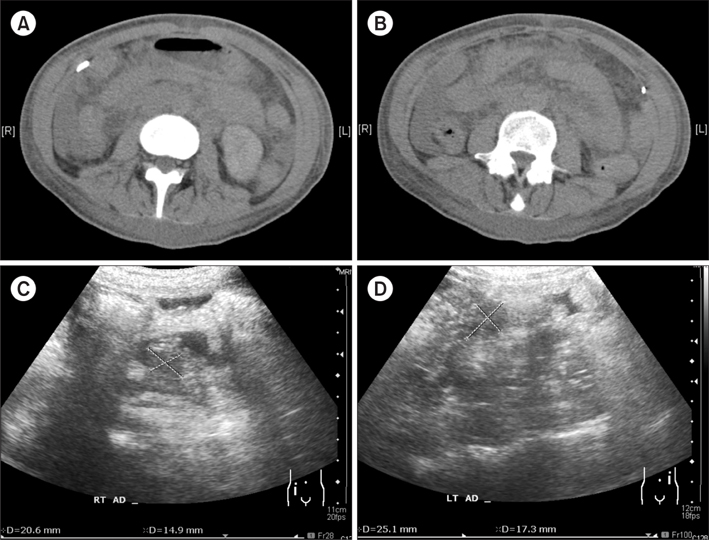J Gynecol Oncol.
2013 Apr;24(2):204-207. 10.3802/jgo.2013.24.2.204.
Maintenance of ovarian function in end-of-life cervical cancer patient following primary surgico-radiotherapy and ovarian transposition
- Affiliations
-
- 1Department of Obstetrics and Gynecology, Medical Center Manila, Manila, Philippines.
- 2Department of Obstetrics and Gynecology, Makati Medical Center, Manila, Philippines.
- 3Department of Obstetrics and Gynecology, Chang Gung Memorial Hospital at Linkou, Chang Gung University College of Medicine, Kwei-Shan, Taiwan. kghuang@ms57.hinet.net
- KMID: 2288552
- DOI: http://doi.org/10.3802/jgo.2013.24.2.204
Abstract
- A 35-year-old woman underwent laparoscopic radical hysterectomy, pelvic lymphadenectomy and ovarian transposition for stage IB2 cervical adenocarcinoma. She received adjuvant concurrent chemoradiation for poor pathologic risk factors but had tumor recurrence 20 months after the surgery. Transposed ovaries were uninvolved in the recurrence and progression. Salvage chemotherapy and radiotherapy were given. Despite systemic chemotherapy and repeat pelvic radiotherapy, the patient was able to maintain ovarian function. Ovarian transposition in cervical cancer is an easily performed procedure that does not alter the prognosis of the disease in some cases. Present recommendations for its use should be reevaluated so that more premenopausal cancer patients may benefit from this underutilized procedure.
Keyword
MeSH Terms
Figure
Reference
-
1. Morice P, Juncker L, Rey A, El-Hassan J, Haie-Meder C, Castaigne D. Ovarian transposition for patients with cervical carcinoma treated by radiosurgical combination. Fertil Steril. 2000. 74:743–748.2. Landoni F, Zanagnolo V, Lovato-Diaz L, Maneo A, Rossi R, Gadducci A, et al. Ovarian metastases in early-stage cervical cancer (IA2-IIA): a multicenter retrospective study of 1965 patients (a Cooperative Task Force study). Int J Gynecol Cancer. 2007. 17:623–628.3. Yamamoto R, Okamoto K, Yukiharu T, Kaneuchi M, Negishi H, Sakuragi N, et al. A study of risk factors for ovarian metastases in stage Ib-IIIb cervical carcinoma and analysis of ovarian function after a transposition. Gynecol Oncol. 2001. 82:312–316.4. Nakanishi T, Wakai K, Ishikawa H, Nawa A, Suzuki Y, Nakamura S, et al. A comparison of ovarian metastasis between squamous cell carcinoma and adenocarcinoma of the uterine cervix. Gynecol Oncol. 2001. 82:504–509.5. Morice P, Haie-Meder C, Pautier P, Lhomme C, Castaigne D. Ovarian metastasis on transposed ovary in patients treated for squamous cell carcinoma of the uterine cervix: report of two cases and surgical implications. Gynecol Oncol. 2001. 83:605–607.6. Han SS, Kim YH, Lee SH, Kim GJ, Kim HJ, Kim JW, et al. Underuse of ovarian transposition in reproductive-aged cancer patients treated by primary or adjuvant pelvic irradiation. J Obstet Gynaecol Res. 2011. 37:825–829.7. Delgado G, Bundy B, Zaino R, Sevin BU, Creasman WT, Major F. Prospective surgical-pathological study of disease-free interval in patients with stage IB squamous cell carcinoma of the cervix: a Gynecologic Oncology Group study. Gynecol Oncol. 1990. 38:352–357.8. Tewari KS, Monk BJ. DiSaia PJ, Creasman WT, editors. Invasive cervical cancer. Clinical gynecologic oncology. 2007. 7th ed. Philadelphia: Mosby Elsevier;51–120.9. Steigrad S, Hacker NF, Kolb B. In vitro fertilization surrogate pregnancy in a patient who underwent radical hysterectomy followed by ovarian transposition, lower abdominal wall radiotherapy, and chemotherapy. Fertil Steril. 2005. 83:1547–1549.10. Kovacs P, Stangel JJ, Santoro NF, Lieman H. Successful pregnancy after transient ovarian failure following treatment of symptomatic leiomyomata. Fertil Steril. 2002. 77:1292–1295.
- Full Text Links
- Actions
-
Cited
- CITED
-
- Close
- Share
- Similar articles
-
- A case of ovarian metastasis on transposed ovary in patient treated for uterine cervical cancer
- A Case of Multiple Primary Cancer with Cervical Adenocarcinoma and both Ovarian Endometrioid Adenocarcinoma
- A case of multiple primary malignancies following radiotherapy for adenosquamous cell carcinoma of the cervix
- Ovarian tissue cryopreservation and transplantation in patients with cancer
- Ovarian Metastasis from Stage IB Cervical Adenocarcinoma: A Case Report



